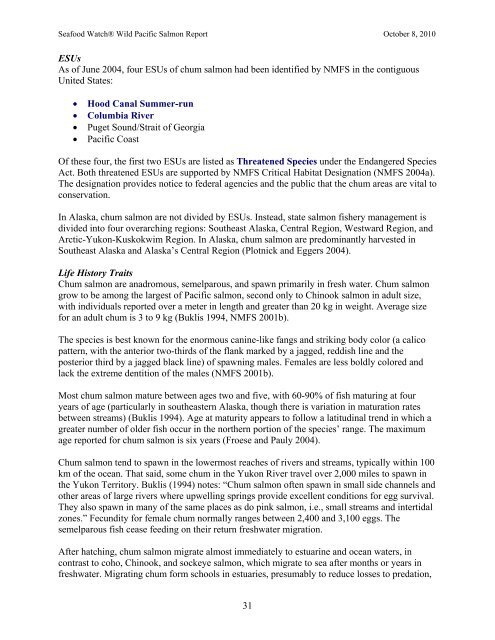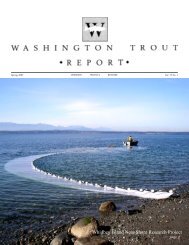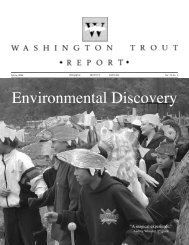Seafood Watch
Pacific Salmon - Wild Fish Conservancy
Pacific Salmon - Wild Fish Conservancy
- No tags were found...
Create successful ePaper yourself
Turn your PDF publications into a flip-book with our unique Google optimized e-Paper software.
<strong>Seafood</strong> <strong>Watch</strong>® Wild Pacific Salmon Report October 8, 2010<br />
ESUs<br />
As of June 2004, four ESUs of chum salmon had been identified by NMFS in the contiguous<br />
United States:<br />
• Hood Canal Summer-run<br />
• Columbia River<br />
• Puget Sound/Strait of Georgia<br />
• Pacific Coast<br />
Of these four, the first two ESUs are listed as Threatened Species under the Endangered Species<br />
Act. Both threatened ESUs are supported by NMFS Critical Habitat Designation (NMFS 2004a).<br />
The designation provides notice to federal agencies and the public that the chum areas are vital to<br />
conservation.<br />
In Alaska, chum salmon are not divided by ESUs. Instead, state salmon fishery management is<br />
divided into four overarching regions: Southeast Alaska, Central Region, Westward Region, and<br />
Arctic-Yukon-Kuskokwim Region. In Alaska, chum salmon are predominantly harvested in<br />
Southeast Alaska and Alaska’s Central Region (Plotnick and Eggers 2004).<br />
Life History Traits<br />
Chum salmon are anadromous, semelparous, and spawn primarily in fresh water. Chum salmon<br />
grow to be among the largest of Pacific salmon, second only to Chinook salmon in adult size,<br />
with individuals reported over a meter in length and greater than 20 kg in weight. Average size<br />
for an adult chum is 3 to 9 kg (Buklis 1994, NMFS 2001b).<br />
The species is best known for the enormous canine-like fangs and striking body color (a calico<br />
pattern, with the anterior two-thirds of the flank marked by a jagged, reddish line and the<br />
posterior third by a jagged black line) of spawning males. Females are less boldly colored and<br />
lack the extreme dentition of the males (NMFS 2001b).<br />
Most chum salmon mature between ages two and five, with 60-90% of fish maturing at four<br />
years of age (particularly in southeastern Alaska, though there is variation in maturation rates<br />
between streams) (Buklis 1994). Age at maturity appears to follow a latitudinal trend in which a<br />
greater number of older fish occur in the northern portion of the species’ range. The maximum<br />
age reported for chum salmon is six years (Froese and Pauly 2004).<br />
Chum salmon tend to spawn in the lowermost reaches of rivers and streams, typically within 100<br />
km of the ocean. That said, some chum in the Yukon River travel over 2,000 miles to spawn in<br />
the Yukon Territory. Buklis (1994) notes: “Chum salmon often spawn in small side channels and<br />
other areas of large rivers where upwelling springs provide excellent conditions for egg survival.<br />
They also spawn in many of the same places as do pink salmon, i.e., small streams and intertidal<br />
zones.” Fecundity for female chum normally ranges between 2,400 and 3,100 eggs. The<br />
semelparous fish cease feeding on their return freshwater migration.<br />
After hatching, chum salmon migrate almost immediately to estuarine and ocean waters, in<br />
contrast to coho, Chinook, and sockeye salmon, which migrate to sea after months or years in<br />
freshwater. Migrating chum form schools in estuaries, presumably to reduce losses to predation,<br />
31






